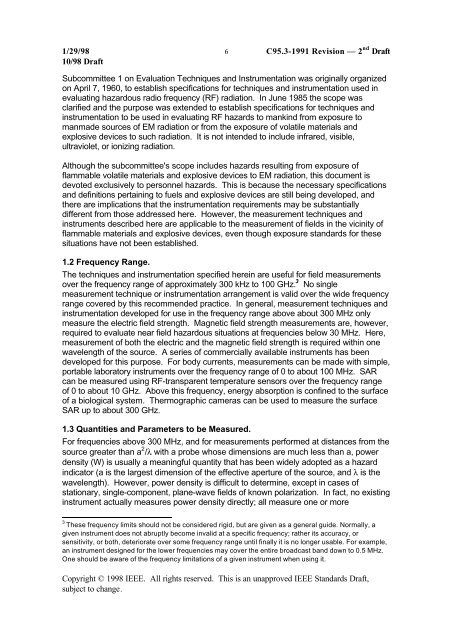DRAFT Recommended Practice for Measurements and ...
DRAFT Recommended Practice for Measurements and ...
DRAFT Recommended Practice for Measurements and ...
Create successful ePaper yourself
Turn your PDF publications into a flip-book with our unique Google optimized e-Paper software.
1/29/98 6 C95.3-1991 Revision — 2 nd Draft<br />
10/98 Draft<br />
Subcommittee 1 on Evaluation Techniques <strong>and</strong> Instrumentation was originally organized<br />
on April 7, 1960, to establish specifications <strong>for</strong> techniques <strong>and</strong> instrumentation used in<br />
evaluating hazardous radio frequency (RF) radiation. In June 1985 the scope was<br />
clarified <strong>and</strong> the purpose was extended to establish specifications <strong>for</strong> techniques <strong>and</strong><br />
instrumentation to be used in evaluating RF hazards to mankind from exposure to<br />
manmade sources of EM radiation or from the exposure of volatile materials <strong>and</strong><br />
explosive devices to such radiation. It is not intended to include infrared, visible,<br />
ultraviolet, or ionizing radiation.<br />
Although the subcommittee's scope includes hazards resulting from exposure of<br />
flammable volatile materials <strong>and</strong> explosive devices to EM radiation, this document is<br />
devoted exclusively to personnel hazards. This is because the necessary specifications<br />
<strong>and</strong> definitions pertaining to fuels <strong>and</strong> explosive devices are still being developed, <strong>and</strong><br />
there are implications that the instrumentation requirements may be substantially<br />
different from those addressed here. However, the measurement techniques <strong>and</strong><br />
instruments described here are applicable to the measurement of fields in the vicinity of<br />
flammable materials <strong>and</strong> explosive devices, even though exposure st<strong>and</strong>ards <strong>for</strong> these<br />
situations have not been established.<br />
1.2 Frequency Range.<br />
The techniques <strong>and</strong> instrumentation specified herein are useful <strong>for</strong> field measurements<br />
over the frequency range of approximately 300 kHz to 100 GHz. 3 No single<br />
measurement technique or instrumentation arrangement is valid over the wide frequency<br />
range covered by this recommended practice. In general, measurement techniques <strong>and</strong><br />
instrumentation developed <strong>for</strong> use in the frequency range above about 300 MHz only<br />
measure the electric field strength. Magnetic field strength measurements are, however,<br />
required to evaluate near field hazardous situations at frequencies below 30 MHz. Here,<br />
measurement of both the electric <strong>and</strong> the magnetic field strength is required within one<br />
wavelength of the source. A series of commercially available instruments has been<br />
developed <strong>for</strong> this purpose. For body currents, measurements can be made with simple,<br />
portable laboratory instruments over the frequency range of 0 to about 100 MHz. SAR<br />
can be measured using RF-transparent temperature sensors over the frequency range<br />
of 0 to about 10 GHz. Above this frequency, energy absorption is confined to the surface<br />
of a biological system. Thermographic cameras can be used to measure the surface<br />
SAR up to about 300 GHz.<br />
1.3 Quantities <strong>and</strong> Parameters to be Measured.<br />
For frequencies above 300 MHz, <strong>and</strong> <strong>for</strong> measurements per<strong>for</strong>med at distances from the<br />
source greater than a 2 /λ with a probe whose dimensions are much less than a, power<br />
density (W) is usually a meaningful quantity that has been widely adopted as a hazard<br />
indicator (a is the largest dimension of the effective aperture of the source, <strong>and</strong> λ is the<br />
wavelength). However, power density is difficult to determine, except in cases of<br />
stationary, single-component, plane-wave fields of known polarization. In fact, no existing<br />
instrument actually measures power density directly; all measure one or more<br />
3 These frequency limits should not be considered rigid, but are given as a general guide. Normally, a<br />
given instrument does not abruptly become invalid at a specific frequency; rather its accuracy, or<br />
sensitivity, or both, deteriorate over some frequency range until finally it is no longer usable. For example,<br />
an instrument designed <strong>for</strong> the lower frequencies may cover the entire broadcast b<strong>and</strong> down to 0.5 MHz.<br />
One should be aware of the frequency limitations of a given instrument when using it.<br />
Copyright © 1998 IEEE. All rights reserved. This is an unapproved IEEE St<strong>and</strong>ards Draft,<br />
subject to change.
















